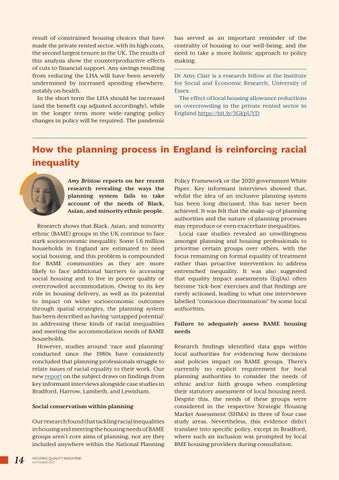result of constrained housing choices that have made the private rented sector, with its high costs, the second largest tenure in the UK. The results of this analysis show the counterproductive effects of cuts to financial support. Any savings resulting from reducing the LHA will have been severely undermined by increased spending elsewhere, notably on health. In the short term the LHA should be increased (and the benefit cap adjusted accordingly), while in the longer term more wide-ranging policy changes in policy will be required. The pandemic
has served as an important reminder of the centrality of housing to our well-being, and the need to take a more holistic approach to policy making. Dr Amy Clair is a research fellow at the Institute for Social and Economic Research, University of Essex. The effect of local housing allowance reductions on overcrowding in the private rented sector in England https://bit.ly/3GkpUYD
How the planning process in England is reinforcing racial inequality Amy Bristow reports on her recent research revealing the ways the planning system fails to take account of the needs of Black, Asian, and minority ethnic people. Research shows that Black, Asian, and minority ethnic (BAME) groups in the UK continue to face stark socioeconomic inequality. Some 1.6 million households in England are estimated to need social housing, and this problem is compounded for BAME communities as they are more likely to face additional barriers to accessing social housing and to live in poorer quality or overcrowded accommodation. Owing to its key role in housing delivery, as well as its potential to impact on wider socioeconomic outcomes through spatial strategies, the planning system has been described as having ‘untapped potential’ in addressing these kinds of racial inequalities and meeting the accommodation needs of BAME households. However, studies around ‘race and planning’ conducted since the 1980s have consistently concluded that planning professionals struggle to relate issues of racial equality to their work. Our new report on the subject draws on findings from key informant interviews alongside case studies in Bradford, Harrow, Lambeth, and Lewisham. Social conservatism within planning Our research found that tackling racial inequalities in housing and meeting the housing needs of BAME groups aren’t core aims of planning, nor are they included anywhere within the National Planning
14
HOUSING QUALITY MAGAZINE NOVEMBER 2021
Policy Framework or the 2020 government White Paper. Key informant interviews showed that, whilst the idea of an inclusive planning system has been long discussed, this has never been achieved. It was felt that the make-up of planning authorities and the nature of planning processes may reproduce or even exacerbate inequalities. Local case studies revealed an unwillingness amongst planning and housing professionals to prioritise certain groups over others, with the focus remaining on formal equality of treatment rather than proactive intervention to address entrenched inequality. It was also suggested that equality impact assessments (EqIAs) often become ‘tick-box’ exercises and that findings are rarely actioned, leading to what one interviewee labelled “conscious discrimination” by some local authorities. Failure to adequately assess BAME housing needs Research findings identified data gaps within local authorities for evidencing how decisions and policies impact on BAME groups. There’s currently no explicit requirement for local planning authorities to consider the needs of ethnic and/or faith groups when completing their statutory assessment of local housing need. Despite this, the needs of these groups were considered in the respective Strategic Housing Market Assessment (SHMA) in three of four case study areas. Nevertheless, this evidence didn’t translate into specific policy, except in Bradford, where such an inclusion was prompted by local BME housing providers during consultation.



